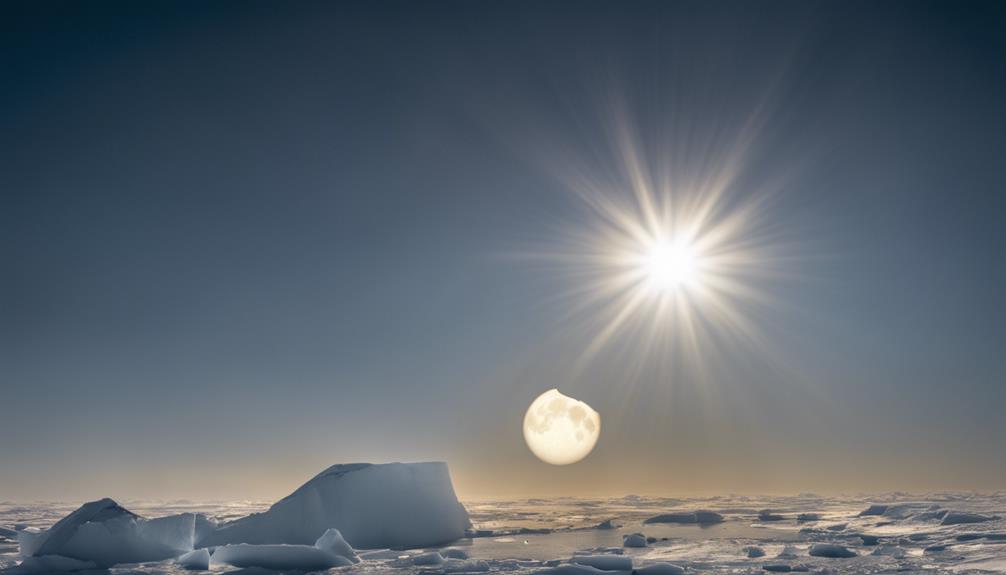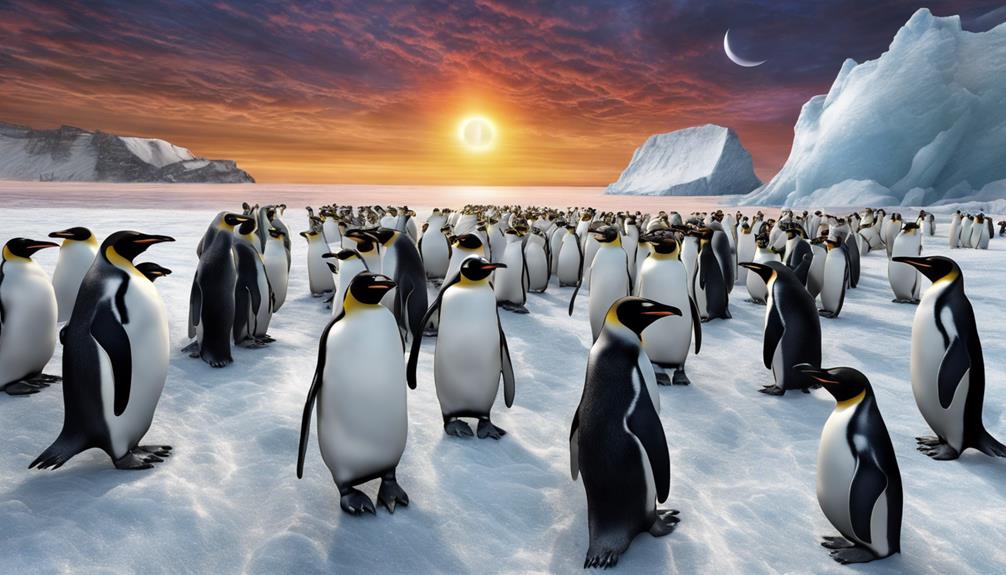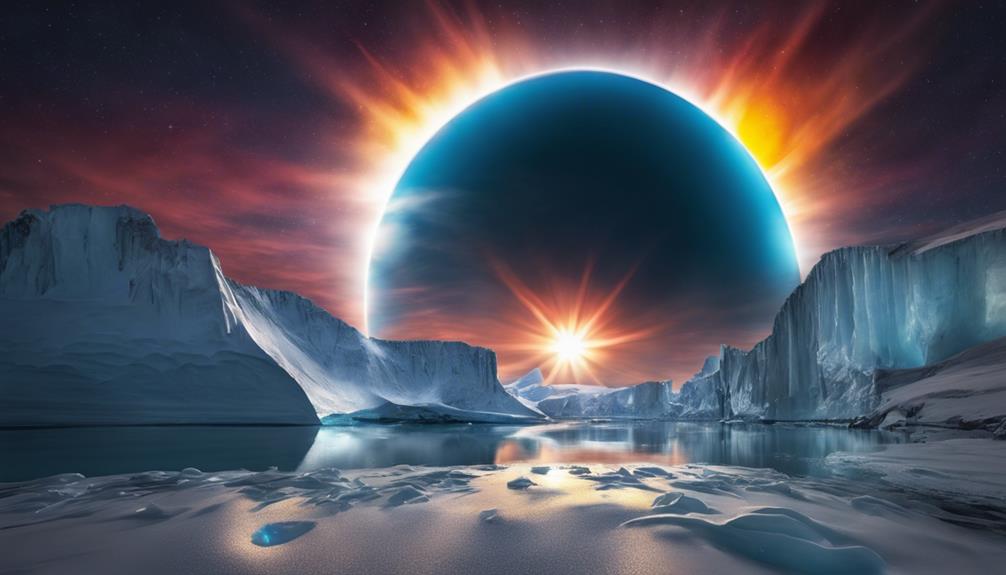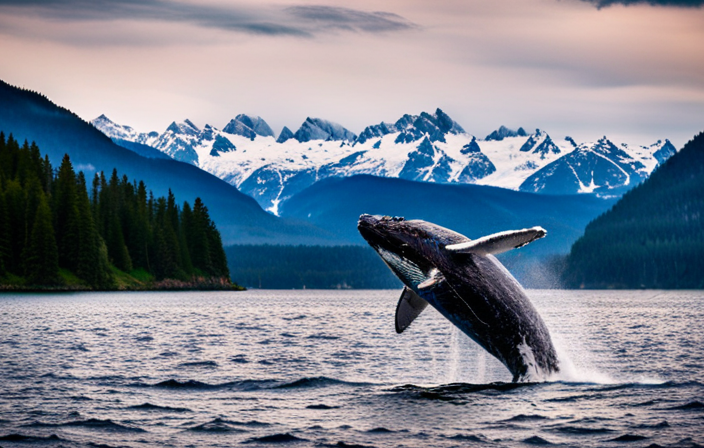Can you envision experiencing a solar eclipse amidst the immense, icy terrains of Antarctica, where the celestial ballet of the cosmos intertwines with the frozen wilderness?
The event held on December 4, 2021, was not just a mere spectacle in the sky. It unfolded a series of scientific phenomena that left many in awe of the mysteries of our universe.
As we explore the significance of this rare celestial phenomenon, we uncover a tapestry of connections between Earth, space, and the celestial bodies that govern our existence.
Key Takeaways
- Rare total solar eclipse in Antarctica on December 4, 2021
- Unique opportunity for exclusive viewing in the Southern Hemisphere
- Valuable data collected on Earth's upper atmosphere electricity flow
- Adelie penguins exhibited distinct behaviors during the celestial event
Eclipse Viewing Locations in Antarctica
Located across the Ronne ice shelf and Ellsworth land, the eclipse viewing locations in Antarctica provided observers with a unique opportunity to witness the total solar eclipse on December 4, 2021. Being situated in the Southern Hemisphere, Antarctica offers a distinct vantage point for celestial events such as solar eclipses. The remote and pristine environment of Antarctica allows for unparalleled viewing conditions, making it an ideal location for observing astronomical phenomena.
During the total solar eclipse, observers in Antarctica experienced near-complete darkness as the moon passed between the sun and the Earth. Researchers and residents stationed in various locations across the continent were able to witness and study this rare event, contributing valuable data to scientific understanding.
The eclipse viewing locations in Antarctica not only offered a visually striking experience but also provided a platform for conducting research and furthering our knowledge of solar phenomena in one of the most isolated and untouched regions on Earth.
Solar Eclipse Timings and Duration

The timing and duration of the total solar eclipse in Antarctica on December 4, 2021, were significant factors in the observation and study of this celestial event. The eclipse had its maximum at 0733 GMT, passing over the Ronne ice shelf and Ellsworth land in Antarctica.
The duration of the total solar eclipse varied depending on the specific location, offering a unique viewing experience for observers. Being visible only in Antarctica, this event was incredibly rare, adding to its exclusivity and allure. The next total solar eclipse in Antarctica isn't expected until 2039, emphasizing the importance of this recent occurrence for researchers and enthusiasts alike.
- The eclipse peaked at 0733 GMT.
- It traversed the Ronne ice shelf and Ellsworth land.
- Duration varied based on location.
- Exclusive visibility in Antarctica.
- Next event not until 2039.
Capturing the Solar Eclipse Phenomenon
As observers documented the rare celestial event of the total solar eclipse in Antarctica on December 4, 2021, various innovative methods were employed to capture this captivating solar phenomenon. NASA's DSCOVR satellite played a crucial role in providing a unique perspective from space by capturing the Moon's shadow covering Antarctica during the eclipse. This satellite imagery offered a bird's eye view of the eclipse's path over the icy terrain, enhancing our understanding of this natural spectacle.
On the ground, researchers at the Amundsen-Scott South Pole Station utilized specialized equipment to observe the partial eclipse, shedding light on the distinct solar movements experienced at Earth's poles. Additionally, scientists studying electricity flow in Earth's upper atmosphere took advantage of this rare event to gather valuable data and insights. Their research during the eclipse provided a natural experiment, offering a unique opportunity to investigate the effects of this celestial phenomenon on the flow of electricity high above Antarctica.
Unique Wildlife Reactions to Eclipse

Studying wildlife reactions to the solar eclipse in Antarctica revealed intriguing behaviors among Adelie penguins at various colonies.
- Adelie penguins at the Cape Crozier colony displayed unique vocalizing behavior during the eclipse, indicating a possible response to the sudden change in light conditions.
- Researchers noted heightened activity levels among Adelie penguins as the solar event progressed, suggesting a potential disruption in their daily routines.
- Some penguins were observed huddling together closely during the eclipse, possibly seeking comfort or safety in response to the unusual phenomenon.
- Male penguins were seen engaging in more territorial displays than usual, indicating a shift in their social dynamics possibly linked to the eclipse.
- The eclipse provided a rare opportunity for scientists to document and analyze the immediate reactions of Adelie penguins to a celestial event, shedding light on how wildlife responds to natural phenomena in the harsh environment of the Antarctic Peninsula.
Solar Eclipse Scientific Significance
Upon analyzing the total solar eclipse over Antarctica on December 4, 2021, researchers anticipate deriving significant scientific insights regarding the flow of electricity in Earth's upper atmosphere.
The unique opportunity presented by the solar eclipse allows scientists to observe the behavior of electrical currents in the space environment during this rare celestial event. By observing the eclipse, researchers can gather data that aids in understanding the dynamics of Earth's upper atmosphere, particularly how it responds to the sudden changes in solar radiation caused by the moon blocking the sun.
This information is crucial for comprehending the interactions between Earth's magnetic field and the influx of solar energy, which can have implications for space weather forecasting and satellite communications. The solar eclipse in Antarctica serves as a natural laboratory for studying these phenomena, offering a glimpse into the intricate mechanisms governing our planet's atmospheric electricity flow.
Through meticulous analysis of the eclipse's effects, researchers aim to unlock valuable scientific insights that contribute to our understanding of Earth's complex atmospheric processes.
Frequently Asked Questions
Does Antarctica Have Solar Eclipse?
Yes, Antarctica does experience solar eclipses. These rare celestial events offer unique opportunities for research and observation. The recent total solar eclipse in December 2021 was a notable occurrence, visible only in Antarctica and providing valuable data for scientific study.
Why Is a Solar Eclipse Rare?
Solar eclipses are rare due to the precise alignment required between the Sun, Moon, and Earth. The Moon's orbit is tilted, causing most new moons to miss the Sun. When the Moon's shadow falls on Earth, a total solar eclipse occurs.
When Was the Last Total Solar Eclipse in Antarctica?
The last total solar eclipse in Antarctica occurred on December 4, 2021. It was visible only there, passing over the Ronne ice shelf and Ellsworth land. The maximum eclipse time was 0733 GMT that day.
When Was the Last Total Eclipse?
When was the last total eclipse? We saw it on December 4, 2021. It was an awe-inspiring sight. The next one won't grace our skies until 2039. Let's cherish these celestial moments while we can.
Conclusion
As we reflect on the unforgettable solar eclipse in Antarctica, we're left in awe of the rare celestial event we were fortunate to witness. The unique insights gained from studying electricity flow in Earth's upper atmosphere during the eclipse raise intriguing questions about our planet's cosmic interactions.
How does the dance of light and shadow during such a phenomenon shape our understanding of the universe? The answers lie in the data collected and the experiences shared during this extraordinary event.
Claire, a creative soul with an unquenchable thirst for storytelling, is an integral part of the Voyager Info team. As a dedicated writer, she weaves captivating narratives that transport readers to enchanting cruise destinations and beyond.
Claire’s love affair with writing began at an early age when she discovered the magic of words and their ability to craft worlds and emotions. Her innate curiosity led her to explore various literary genres, but it was travel writing that truly captured her heart. Drawing inspiration from her own globetrotting adventures and encounters with diverse cultures, Claire embarked on a journey to become a travel writer par excellence.











